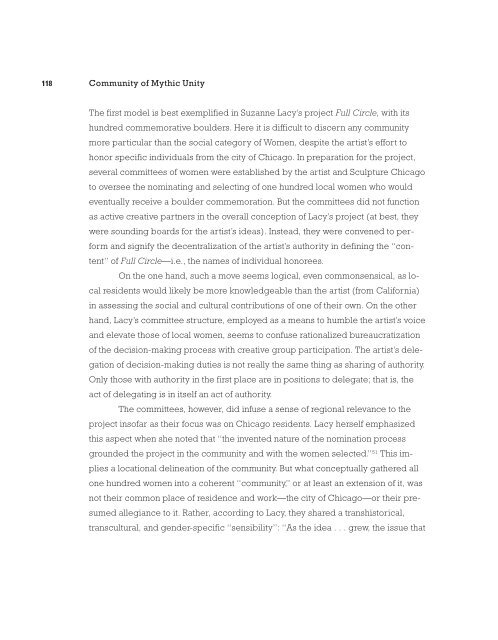ONE PLACE AFTER ANOTHER - Monoskop
ONE PLACE AFTER ANOTHER - Monoskop
ONE PLACE AFTER ANOTHER - Monoskop
Create successful ePaper yourself
Turn your PDF publications into a flip-book with our unique Google optimized e-Paper software.
118<br />
Community of Mythic Unity<br />
The first model is best exemplified in Suzanne Lacy’s project Full Circle, with its<br />
hundred commemorative boulders. Here it is difficult to discern any community<br />
more particular than the social category of Women, despite the artist’s effort to<br />
honor specific individuals from the city of Chicago. In preparation for the project,<br />
several committees of women were established by the artist and Sculpture Chicago<br />
to oversee the nominating and selecting of one hundred local women who would<br />
eventually receive a boulder commemoration. But the committees did not function<br />
as active creative partners in the overall conception of Lacy’s project (at best, they<br />
were sounding boards for the artist’s ideas). Instead, they were convened to perform<br />
and signify the decentralization of the artist’s authority in defining the “content”<br />
of Full Circle—i.e., the names of individual honorees.<br />
On the one hand, such a move seems logical, even commonsensical, as lo-<br />
cal residents would likely be more knowledgeable than the artist (from California)<br />
in assessing the social and cultural contributions of one of their own. On the other<br />
hand, Lacy’s committee structure, employed as a means to humble the artist’s voice<br />
and elevate those of local women, seems to confuse rationalized bureaucratization<br />
of the decision-making process with creative group participation. The artist’s delegation<br />
of decision-making duties is not really the same thing as sharing of authority.<br />
Only those with authority in the first place are in positions to delegate; that is, the<br />
act of delegating is in itself an act of authority.<br />
The committees, however, did infuse a sense of regional relevance to the<br />
project insofar as their focus was on Chicago residents. Lacy herself emphasized<br />
this aspect when she noted that “the invented nature of the nomination process<br />
grounded the project in the community and with the women selected.” 51 This implies<br />
a locational delineation of the community. But what conceptually gathered all<br />
one hundred women into a coherent “community,” or at least an extension of it, was<br />
not their common place of residence and work—the city of Chicago—or their presumed<br />
allegiance to it. Rather, according to Lacy, they shared a transhistorical,<br />
transcultural, and gender-specific “sensibility”: “As the idea . . . grew, the issue that

















